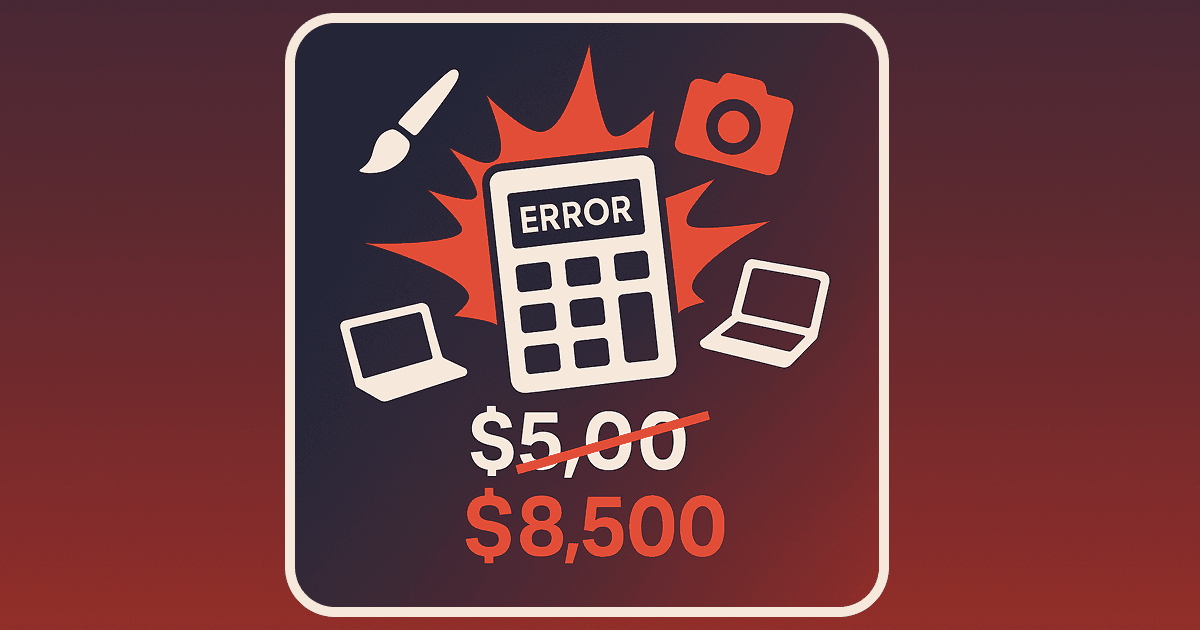Why Creative Projects Always Go Over Budget (And How to Fix It)

If you're a creative freelancer, agency owner, or part of a design team, you've probably experienced this nightmare scenario: You quote a client $5,000 for a website redesign, feel confident about the timeline, and then... three weeks later, you're still working on "just a few small tweaks" while your profit margin evaporates.
Sound familiar? You're not alone. Research shows that creative projects go over budget 70% of the time, and it's not because creatives are bad at math. The problem runs much deeper, and understanding these root causes is the first step to fixing your estimation process once and for all.
Table of Contents
The Real Reasons Creative Budgets Explode
The "Creative Process" is Unpredictable
Unlike manufacturing a widget, creativity doesn't follow a linear path. That brilliant logo concept might come in 10 minutes, or it might take 10 iterations. We often estimate based on our best-case scenarios, not reality.
Scope Creep Disguised as "Collaboration"
Clients love to be involved in the creative process. "Can we try it in blue?" turns into a complete color palette overhaul. "What if we moved this element?" becomes a full layout redesign. Each "small change" chips away at your budget.
Underestimating Revision Cycles
We think in terms of "draft → feedback → final," but reality is more like "draft → feedback → revision → more feedback → another revision → 'just one tiny change' → final." Those revision cycles add up fast.
The Tools We Use Don't Match Our Workflow
Most creatives still use Excel or Google Sheets for project estimation. But spreadsheets can't account for the iterative nature of creative work, team collaboration, or client feedback loops.
How to Fix Your Budget Problems (For Good)
Build Buffer Time Into Every Estimate
Stop estimating your best-case scenario. Instead, use the PERT estimation method (Program Evaluation and Review Technique):
- Optimistic estimate: How long it takes when everything goes perfectly
- Pessimistic estimate: How long it takes when everything goes wrong
- Most likely estimate: Your realistic expectation
Formula: (Optimistic + 4 × Most Likely + Pessimistic) ÷ 6
This gives you a much more accurate timeline that accounts for creative uncertainty.
Create Clear Revision Boundaries
Instead of unlimited revisions, structure your packages:
- Package 1: 2 concepts + 3 revision rounds
- Package 2: 3 concepts + 5 revision rounds
- Package 3: Custom scope
Make it clear that additional revisions are billable. This protects your time and helps clients make decisions faster.
Track Your Actual Time vs. Estimates
The only way to get better at estimation is to measure reality against your predictions. Keep simple time logs for each project phase:
- Initial concept development
- Client presentation prep
- Revision rounds
- Final delivery & handoff
After 5-10 projects, you'll start seeing patterns in where you consistently under-estimate.
Use Tools Built for Creative Workflows
Here's where most creatives get stuck. Excel works for basic math, but it can't handle:
- Multiple estimate versions (different scope options)
- Team collaboration on estimates
- Client approval workflows
- Automated calculations based on your team's real rates
For teams serious about fixing their estimation problems, tools like Doofer.io are specifically designed for project estimation. It handles PERT estimation automatically, lets you create multiple versions of the same project estimate, and even tracks how clients interact with your proposals.
What's particularly useful for creative teams is the automated calculation feature. You can set rules like "QA review = 15% of design time" or "Client revisions = 25% of initial concept time," and the tool automatically factors these into your estimates.
The platform also offers ready-to-use estimation templates for common creative projects, which can save hours of setup time for each new client proposal.
Communicate Costs Upfront
Transparency builds trust. When presenting estimates, explain your methodology:
- "This timeline includes buffer time for revision rounds"
- "Additional changes beyond scope will be billed at $X/hour"
- "We've factored in QA time and client feedback cycles"
Clients appreciate seeing the thought process behind your numbers.
The Bottom Line
Creative projects don't have to be budget disasters. The key is moving from gut-feeling estimates to systematic approaches that account for the realities of creative work.
Start with one change: next project, try the PERT estimation method instead of pulling numbers from thin air. Track your actual time against that estimate. After a few projects, you'll have data to build better estimates.
Remember, accurate estimation isn't about limiting creativity - it's about protecting the time and space you need to do your best creative work without financial stress.
Looking for more tools to streamline your creative workflow? Check out our font generator and other free creative tools to enhance your design process.

VibeBerry Team